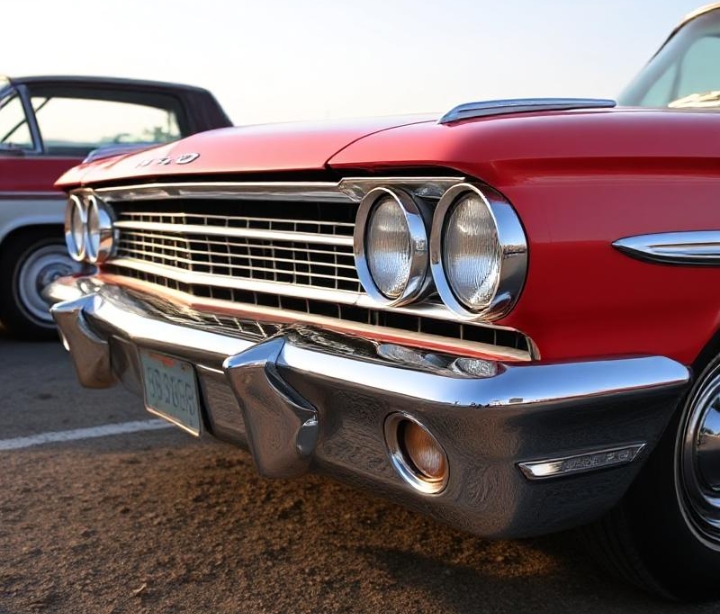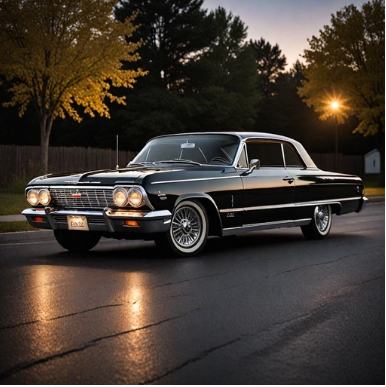The Evolution of the Ford Galaxie: A Symbol of American Automotive Excellence
The Ford Galaxie, an iconic model that encapsulates the American automobile industry’s heyday, was produced from 1959 to 1974. Renowned for its blend of performance, luxury, and comfort, the Galaxie was a full-size car that underwent significant transformations over its 15-year production run. As an emblem of post-war optimism and a response to shifting consumer demands, the Galaxie reflects changing automotive trends and tastes throughout the decades.
1. Introduction: The Birth of the Galaxie (1959–1960)
The Ford Galaxie was introduced in 1959 as Ford’s flagship full-size car. At this time, Ford restructured its lineup, and the Galaxie emerged as a replacement for the Fairlane 500 series. The Galaxie was distinguishable due to its sleek styling, powerful engines, and spacious interiors, making it an immediate hit among consumers.
1959: The Launch
The inaugural year featured a number of exciting design elements, including a broad, low-slung body, elaborate chrome accents, and tailfins that were popular in the era. The 1959 model was offered in various configurations: the base Galaxie, the Galaxie 500, which added more luxury features, and the Galaxie 500/XL, which included bucket seats and a more performance-oriented approach.
Trim Levels for 1959:
- Ford Galaxie
- Ford Galaxie 500
- Ford Galaxie 500/XL
1960: Refinements and New Features
In 1960, the Galaxie’s styling was updated slightly to include more curved lines and a unique rear design. The Galaxie lineup expanded with the introduction of the Starliner and Skyliner models, which featured sleek fastback designs and innovative retractable hardtops.
Trim Levels for 1960:
- Ford Galaxie
- Ford Galaxie 500
- Ford Galaxie 500/XL
- Ford Starliner
- Ford Skyliner
.

.
2. The Mid-1960s: The Golden Age of the Galaxie (1961–1965)
The early 1960s saw the Galaxie solidify its position in the market, with steady sales and a growing reputation for performance. Ford engineers fine-tuned the existing models and enhanced the powertrain options.
1961: Bulkier Designs and Performance Upgrades
The 1961 model featured a more substantial body and a refreshed appearance. Engine options included the standard 223 cubic-inch six-cylinder and a range of V8 engines up to 390 cubic inches, offering excellent performance.
Trim Levels for 1961:
- Ford Galaxie
- Ford Galaxie 500
- Ford Galaxie 500/XL
- Ford Starliner
1962–1964: The Crossover years
The Galaxie received another design tweak in 1962, introducing a more sculpted look. The introduction of the “Galaxie 500/XL” remained the top-tier model, equipped with powerful engines that made it competitive in the growing muscle car market. The 1963 model year saw a rise in performance-focused variants, including the introduction of the 427 cubic-inch V8.
Trim Levels for 1962-1964:
- Ford Galaxie
- Ford Galaxie 500
- Ford Galaxie 500/XL
- Ford 427 (High-Performance variant)
1965: The Iconic 1965 Model
The 1965 Galaxie represents one of the most recognized models in the line’s history. Changes included a redesigned grille and hood. The 1965 model maintained the traditional Galaxie elegance while incorporating more powerful engine options, making it popular among performance enthusiasts and families alike.
Trim Levels for 1965:
- Ford Galaxie
- Ford Galaxie 500
- Ford Galaxie 500/XL
- Ford XL (Luxury variant)
3. Redefining Full-Size: Late 1960s Galaxie Models (1966–1969)
As the decade progressed, the Galaxie continued to evolve. The larger and more luxurious designs catered to growing consumer demands for comfort and space.
1966: A New Era of Luxury and Performance
In 1966, the Galaxie’s styling was modernized. The new design was broader, featuring a more pronounced grille and a longer hood. Engines were updated as well, with the introduction of the 428 cubic-inch V8 alongside other powertrain enhancements.
Trim Levels for 1966:
- Ford Galaxie
- Ford Galaxie 500
- Ford Galaxie 500/XL
1967–1969: Stronger Performance Lines
The late 1960s saw further enhancement in both styling and performance. The Galaxie was positioned as a luxury car, garnering a reputation for comfort and a smooth ride. By this time, the full-size segment was in competition with the likes of Chevrolet and Chrysler, and Ford responded with product improvements.
Trim Levels for 1967-1969:
- Ford Galaxie
- Ford Galaxie 500
- Ford Galaxie 500/XL
- Ford Country Sedan (a wagon variant)
4. The Final Years: The 1970s (1970–1974)
Entering the 1970s, the Galaxie continued to thrive but faced competition from smaller, more fuel-efficient vehicles as the oil crisis loomed.
1970: Dramatic Styling Changes
The 1970 model featured a longer and wider body style, designed to emulate a more luxurious ride. Engine options still included powerful V8s, though the automobile market was beginning to change significantly due to an emphasis on fuel efficiency.
Trim Levels for 1970:
- Ford Galaxie
- Ford Galaxie 500
- Ford Galaxie 500/XL
- Ford 500 (a more economical variant)
1971–1974: The Decline
By the early 1970s, rising fuel prices and tighter regulations began to take their toll on the Galaxie. Engine options were reduced, with an emphasis shifting towards smaller, fuel-efficient designs. Production of the Galaxie came to an end in 1974, marking the decline of the traditional full-size American car.
Trim Levels for 1971-1974:
- Ford Galaxie
- Ford Galaxie 500
- Ford Galaxie Brougham
Conclusion
The Ford Galaxie is a storied chapter in American automotive history. Its evolution from a stylish full-size car to a prominent symbol of American engineering captures not only the changing tastes in automotive design but also mirrors broader societal shifts. As the industry evolved, so too did the Galaxie, adapting to the needs of consumers across generations. While production ceased in 1974, the Galaxie remains a cherished classic, with collectors and enthusiasts celebrating its legacy of performance, luxury, and inherent American style. Whether seen cruising the streets or displayed at car shows, the Ford Galaxie encapsulates a distinct era in automotive history.







